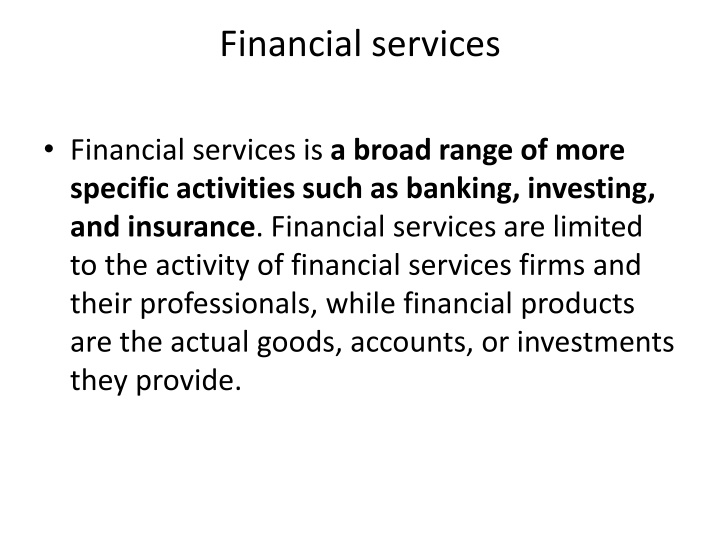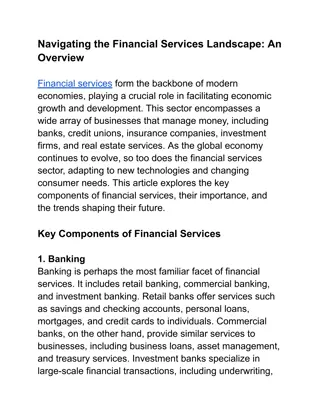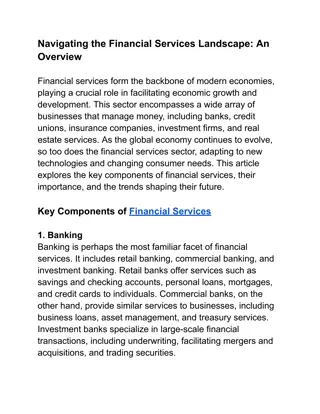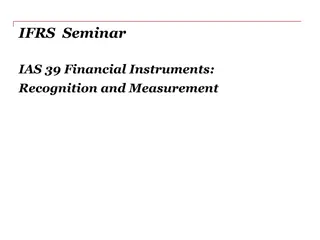Financial Services and Objectives
Financial services encompass a wide range of activities such as banking, investing, and insurance. These services are crucial for fund raising, funds deployment, specialized services, regulation, and economic growth. Learn about different types of financial services like lease financing, hire purchase, factoring, and forfeiting.
Download Presentation

Please find below an Image/Link to download the presentation.
The content on the website is provided AS IS for your information and personal use only. It may not be sold, licensed, or shared on other websites without obtaining consent from the author.If you encounter any issues during the download, it is possible that the publisher has removed the file from their server.
You are allowed to download the files provided on this website for personal or commercial use, subject to the condition that they are used lawfully. All files are the property of their respective owners.
The content on the website is provided AS IS for your information and personal use only. It may not be sold, licensed, or shared on other websites without obtaining consent from the author.
E N D
Presentation Transcript
Financial services Financial services is a broad range of more specific activities such as banking, investing, and insurance. Financial services are limited to the activity of financial services firms and their professionals, while financial products are the actual goods, accounts, or investments they provide.
Objectives of Financial services Fund Raising : The required funds can be raised by the help of financial services from the host of investors, individuals, institutions and corporate. There are various instruments of finance being used for raising funds. These kinds of funds are required by the corporate houses, individuals, etc. 2) Funds Deployment : There are various kinds of financial services present in the financial markets which help the company in proper deployment of funds. It also helps in decision-making of financial mix. The financial service provide various types of services like bill discounting, factoring of debtors, shifting of short-term funds in the money market, credit rating, e-commerce and securitisation of debts for effective funds management. 3) Specialized Services : The various specialized services are being provided by financial service except banking and insurance like credit rating, venture capital financing, lease financing, factoring, mutual funds, merchant banking, stock lending, depository, credit cards, housing finance, book-building, etc. These services are provided by various kinds of institutions and agencies like stock exchanges, specialized and general financial institutions and non-banking finance companies, subsidiaries of financial institutions, banks and insurance companies. etc. 4) Regulation : There are various kinds of regulatory bodies present in India like Securities and Exchange Board of India (SEBI), Reserve Bank of India (RBI) and the Department of Banking and Insurance of the Government of India which have different types of legislation's and also help in providing various kinds of functions of financial services institutions. 5) Economic Growth : The financial services help in increasing the economic growth and development of country. It is done by the help of mobilizing the saving of the public by investing in productive investments. Due to this reason, the various developed and developing countries which are engaged in the effective financial market has increased the savings and investments.
Types of financial services Lease Financing : A lease is known as the agreement between two parties known as lessor and lessee. The lessor is the owner of the asset and lessee is the user of the asset. In this agreement, there is transfer of asset from lessor to lesser for certain time period, in return the lessor receives the regular rent. As the lease period gets over, the asset is returned back to lessor until there is renewal of the contract. 2) Hire Purchase : The hire purchase refers to the hiring of an asset for certain time period and when the time period gets over, there is purchase of same asset. At the time of sharing of asset, the person hiring the asset gets the ownership and is allowed in use it. It is being used for financing of capital goods like industrial finance, financing of consumer goods and for selling consumer good on hire purchase as it is a legal advice.
Factoring : Factoring is done when the company requires immediate money. It is done by selling the account receivable like invoices to a third party known as factor at certain discount for immediate cash. This cash is required for continuous working of the business. 4) Forfeiting : Forfeiting is the way of financing of receivable related to international trade. It represents to the purchase done by bank and financial institutions of trade bills/promissory notes instead of recourse to the seller. The purchase is done by discounting the documents including the overall risk of non-payment in collection. The various problems related to collection are accountability of the purchaser who pays cash to seller after discounting the bills and notes. 5) Mutual Fund : Mutual fund is the type of investment in which the pool of funds is sourced from various investors for investing in various securities like stocks, bonds, money market instruments and similar assets. It is managed by the money managers who invest the fund capital and tries to get capital gains and income for the investors of the fund. The portfolio of mutual fund is organised and is according to the investment objective given in the prospectus.
Merchant Bank A merchant bank is a financial institution that conducts underwriting, loan services, financial advising, and fundraising services for large corporations and high- net-worth individuals (HWNIs). Merchant banks specialize in international trade, providing services for multinational corporations. Unlike retail or commercial banks, merchant banks do not provide financial services to the general public. Some of the largest merchant banks in the world include J.P. Morgan Chase, Goldman Sachs, and Citigroup.
Merchant Bank Functions Project Counselling: Merchant bankers assist their clients at every stage of the project idea generation, report creation, budgeting, and financing. This is especially the case with new entrepreneurs. Leasing Services: The banks extend leasing facilities clients lease assets and equipment to generate rental income. Issue Management: High net-worth individuals employ merchant banks to issue equity shares, preference shares, and debentures to the general public. Underwriting: The banks also facilitate equity underwriting. They assess the price and risk involved in particular security and initiate public issue and distribution of stocks. Fund Raising: Through various facilities like underwriting and securities issuance, bankers help the private companies generate capital from international and domestic markets. Portfolio Management: On behalf of clients, these bankers invest in different kinds of financial instruments. Loan Syndication: They finance term loans to back projects that need funding. Promotional Activities: Merchant banks are financial intermediaries that promote new enterprises.
Establishment Of SEBI The Securities and Exchange Board of India was constituted as a non-statutory body on April 12, 1988 through a resolution of the Government of India. The Securities and Exchange Board of India was established as a statutory body in the year 1992 and the provisions of the Securities and Exchange Board of India Act, 1992 (15 of 1992) came into force on January 30, 1992.
Objectives of SEBI Following are some of the objectives of the SEBI: 1. Investor Protection: This is one of the most important objectives of setting up SEBI. It involves protecting the interests of investors by providing guidance and ensuring that the investment done is safe. 2. Preventing the fraudulent practices and malpractices which are related to trading and regulation of the activities of the stock exchange 3. To develop a code of conduct for the financial intermediaries such as underwriters, brokers, etc. 4. To maintain a balance between statutory regulations and self regulation.
Functions of SEBI SEBI has the following functions 1. Protective Function 2. Regulatory Function 3. Development Function The following functions will be discussed in detail Protective Function: The protective function implies the role that SEBI plays in protecting the investor interest and also that of other financial participants. The protective function includes the following activities. a. Prohibits insider trading: Insider trading is the act of buying or selling of the securities by the insiders of a company, which includes the directors, employees and promoters. To prevent such trading SEBI has barred the companies to purchase their own shares from the secondary market. b. Check price rigging: Price rigging is the act of causing unnatural fluctuations in the price of securities by either increasing or decreasing the market price of the stocks that leads to unexpected losses for the investors. SEBI maintains strict watch in order to prevent such malpractices. c. Promoting fair practices: SEBI promotes fair trade practice and works towards prohibiting fraudulent activities related to trading of securities. d. Financial education provider: SEBI educates the investors by conducting online and offline sessions that provide information related to market insights and also on money management.
Structure of SEBI SEBI board comprises nine members. The Board consists of the following members. One Chairman of the board who is appointed by the Central Government of India One Board member who is appointed by the Central Bank, that is, the RBI Two Board members who are hailing from the Union Ministry of Finance Five Board members who are elected by the Central Government of India
Definition of Hire Purchasing Hire Purchasing is an agreement, in which the hire vendor transfers an asset to the hire purchaser, for consideration. The consideration is in the form of Hire Purchase Price (HPP) which includes cash down payment and instalments. The hire purchase price is normally higher than the cash price of the article because interest charges are included in that price. The instalment paid by the hirer at periodical intervals up to a specified period. The instalment is a sum of finance charges i.e. interest and the capital payment i.e. principal.
Definition of Leasing A contract in which one party (lessor) permits to use the asset for a specified period to another party (lessee) in exchange for periodic payments for a specified time is known as Leasing. Accounting standard 19 deals with leases which apply to all the enterprises, subject to certain exemption. At regular intervals, the lessee pays a sum to the lessor which is known as Lease Rents, as a consideration for using the asset owned by the lessor. In addition to this, the lessor also gets a terminal payment known as Guaranteed Residual Value (GRV). The aggregate of the lease rent and guaranteed residual value is known as Minimum Lease Payments (MLP). If the Lessor receives, the amount more than the guaranteed residual value is known as Unguaranteed Residual Value.
Venture Capital Start up companies with a potential to grow need a certain amount of investment. Wealthy investors like to invest their capital in such businesses with a long- term growth perspective. This capital is known as venture capital and the investors are called venture capitalists. A venture capitalist (VC) is a private equity investor that provides capital to companies with high growth potential in exchange for an equity stake. A VC investment could involve funding startup ventures or supporting small companies that wish to expand but have no access to the equities markets.
mutual funds A mutual fund is a pool of money managed by a professional Fund Manager. It is a trust that collects money from a number of investors who share a common investment objective and invests the same in equities, bonds, money market instruments and/or other securities.
Types of mutual funds Open-ended funds: These funds do not limit when or how many units can be purchased. ... Close-ended funds: ... Interval funds: ... Equity funds: ... Debt funds: ... Hybrid funds: ... Solution-oriented funds: ...
Equity funds: Equity funds invest money in company shares, and their returns depend on how the stock market performs. Though these funds can give high returns, they are also considered risky. They can be categorized further based on their features, like Large-Cap Funds, Mid-Cap Funds, Small-Cap Funds, Focused Funds, or ELSS, among others. Invest in equity funds if you have a long-term horizon and a high- risk appetite. Debt funds: Debt funds invest money into fixed-income securities such as corporate bonds, government securities, and treasury bills. Debt funds can offer stability and a regular income with relatively minimum risk. These schemes can be split further into categories based on duration, like low-duration funds, liquid funds, overnight funds, credit risk funds, gilt funds, among others. Hybrid funds: Hybrid funds invest in both debt and equity instruments so as to balance out debt and equity. The ratio of investment can be fixed or varied, depending on the fund house. The broad types of hybrid funds are balanced or aggressive funds. There are multi asset allocation funds which invest in at least 3 asset classes. Solution-oriented funds: These mutual fund schemes are for specific goals like building funds for children s education or marriage, or for your own retirement. They come with a lock-in period of at least five years.























